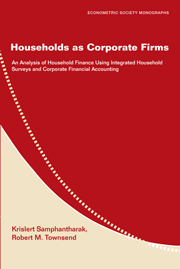 Households as Corporate Firms
Households as Corporate Firms Book contents
- Frontmatter
- Contents
- Preface
- PART I HOUSEHOLDS AS CORPORATE FIRMS
- PART II HOUSEHOLD FINANCIAL ACCOUNTING
- PART III HOUSEHOLD FINANCE
- 5 Financial Analysis
- 6 An Application: Liquidity Constraints, Kinship Networks, and the Financing of Household Investment
- 7 Discussion: Measurement and Modeling
- Appendix: Examples of Financial Statements
- References
- Index
- Titles in the series
7 - Discussion: Measurement and Modeling
Published online by Cambridge University Press: 05 January 2013
- Frontmatter
- Contents
- Preface
- PART I HOUSEHOLDS AS CORPORATE FIRMS
- PART II HOUSEHOLD FINANCIAL ACCOUNTING
- PART III HOUSEHOLD FINANCE
- 5 Financial Analysis
- 6 An Application: Liquidity Constraints, Kinship Networks, and the Financing of Household Investment
- 7 Discussion: Measurement and Modeling
- Appendix: Examples of Financial Statements
- References
- Index
- Titles in the series
Summary
This monograph provides a conceptual framework for viewing households as corporate firms. We show how to construct household financial statements from a household survey and how to use the financial accounts in an analysis of household finance. As a conclusion, this chapter discusses various issues regarding measurement and the modeling of households as corporate firms. Section 7.1 provides the lessons we learned from applying the framework to the Townsend Thai Monthly Survey. Section 7.2 lists the limitations of the financial accounts in general. Finally, section 7.3 concludes with the implications of our work for modeling household behavior in an analysis of household finance.
LESSONS FOR HOUSEHOLD SURVEYS
We use the data from the Townsend Thai Monthly Survey in this monograph. Although that survey serves many of our objectives in the analysis of household financial decisions, it is not perfect and there is room for improvement. We list some of the issues with the data for the benefit of other researchers.
First, we do not keep track of the price changes and market value of fixed assets well enough. Although we do update the value of land when there is a major improvement that affects the value of that land, we do not adjust the market value of other fixed assets until they are sold, when we record the cumulative increase (decrease) in value as capital gain (loss).
- Type
- Chapter
- Information
- Households as Corporate FirmsAn Analysis of Household Finance Using Integrated Household Surveys and Corporate Financial Accounting, pp. 151 - 164Publisher: Cambridge University PressPrint publication year: 2009


